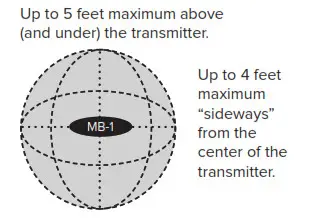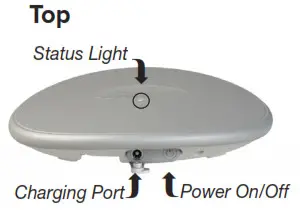
DogWatch® MB-1Product Features and Operating Instructions
The DogWatch® MB-1 is a battery operated indoor/outdoor mobile boundary hidden fence transmitter designed to create small pet-free areas.The MB-1 can be used to train your pet to stay away from specific objects or areas indoors or outdoors, such as the sofa, bed, kitchen table or counter, the trash or cat’s litter box, garden, pool or children’s play area, for example.
How the System Works
The MB-1 transmits a silent radio signal that is recognized by a special receiver collar worn by your pet. The signal can be adjusted from 4 feet to 8 feet in diameter to create a pet-free `avoidance area’.The outer edge of the boundary area is a warning zone. As your pet approaches the warning zone, the receiver collar starts `beeping’ to alert your pet that he is too close to the boundary area. With training (page 3), your pet learns that if he goes beyond the warning zone, the beep is quickly followed by a `correction’ (an unpleasant, but safe, sensation from the receiver collar). Your pet will learn to stay away from areas he associates with the warning beep.
Setting the Boundary Area
Set the signal rate and the range (see pages 2 & 3) then place the MB-1 transmitter in the center of the pet-free area. For example, on a counter, in the garden, near a doorway or under a piece of furniture.Test the signal field and place the training flags before putting the collar on your dog.To locate the signal field, place the test light on the contact posts and move toward the transmitter until you hear the warning beeps. Avoid touching the contact posts.
Signal Range The signal radiates in all directions around the transmitter (as if it were in the center of a large ball).
- The maximum “horizontal” (sideways) signal is 4 feet from the center of the transmitter (8 feet maximum diameter).
- The maximum “vertical” signal above (and under) the transmitter is 5 feet from the top of the transmitter.
Training Flags
The training flags are placed around the edge of the warning zone to mark the pet-free avoidance area. The flags are gradually removed after your pet is trained.

NOTE: Do not position the transmitter on or near large metal objects.

Power on/off
- Turning Power on The status light turns green and blinks several times.
- Turning Power off The status light turns red and then fades out.
Bottom Features and FunctionsThe MB-1 may be used indoors or outdoors. The MB-1 is water resistant but is not intended to be submerged in water/liquid. When used outdoors:
Features and FunctionsThe MB-1 may be used indoors or outdoors. The MB-1 is water resistant but is not intended to be submerged in water/liquid. When used outdoors:
- The flap covering the charging port and the cover over the control panel on the bottom must both be tightly closed. Both are rubber seals which, when tightly closed, will help prevent water damage.
- The unit must be operated via battery.
- Do not place in direct sunlight.Rechargeable Battery – Charge for at least 3 hours before using the first time.The transmitter must be charged indoors. do not plug it in outdoors!To charge the battery, plug the power adapter into an electrical outlet and insert the other end securely into the charging port on the transmitter.
- The MB-1 should be charged only by the DogWatch power adapter.
- Do not leave the transmitter uncharged for long periods.
- Do not leave the MB-1 plugged-in when in use, except when charging.
- Do not charge if the transmitter temperature is below 32of or above 110of.The transmitter charges in approximately 3 hours when `off’ (charging takes longer if it is turned `on’). A protection circuit prevents overcharging.Status Light – The status light lets you know: (a) if the transmitter is turned `on’; and (b) the status of the transmitter battery.
|
STATUS LIGHT GUIDE |
Transmitter ‘On’Boundary Activated |
Transmitter ‘Off’No Boundary Signal |
| Battery Operated | ||
| Battery Charged | Light blinks green every 15 seconds | Light Off |
| Battery Low | Light double blinks red every 15 seconds | Light Off |
| Plugged-In | ||
| Battery Charged | Steady green light blinks ‘off’ every 15 seconds | Light Off |
| Battery Charging* | Steady red light blinks ‘off’ every 15 seconds | Steady red light |
*When turned `on’, the transmitter is sending a signal, even while charging.
Signal Range – Signal range is the distance the signal radiates from the center of the transmitter.
- Turn the knob toward `max’ to increase the size of the signal field.
- Turn the knob toward `min’ to decrease the size of the signal field.Never adjust the signal range while your pet is wearing the receiver collar. Always test the signal field and mark the edge of the field with flags before allowing your pet near the boundary area.
Frequency – Controls the broadcast frequency of the signal. Do NOT change this setting.
Rate Setting – The Rate Setting determines how frequently the signal is transmitted. The rate you select depends on your objective:Fast – The `Fast’ setting transmits the signal in very rapid pulses to create the most secure boundary. `Fast’ is recommended during the training phase and also when a secure boundary is very important, such as when you need to keep your pet from running through a doorway.NOTE: The `Fast’ setting only transmits at the `Fast’ rate in the battery operated mode. The `Fast’ setting defaults to `Medium’ when the transmitter is plugged-in.Medium – On the `Medium’ setting, the signal transmits at a slightly slower rate to help conserve the battery charge. The `Medium’ setting is recommended when your pet has been trained to understand his boundaries but still needs reinforcement of the training.Slow – On the `Slow’ setting, the signal transmits at the slowest rate so the battery stays charged longer. The `Slow’ setting is recommended for pets who have been trained and who usually respect their boundaries but may need an occasional `reminder’.
Time between charges varies depending on both the Rate setting and the Range setting.
| • 3½ days in ‘Fast’• 7 days in ‘Medium’• 30 days in ‘Slow’. | Decreasing the range increases the average battery life between charges.Cold weather decreases the average battery life between charges. |
Training
- Place the transmitter in the center of the area where you want to create a signal field. Before putting the receiver collar on your pet, place boundary flags on the edge of the signal field just past where the receiver collar picks up the audible signal. The boundary flags serve as visual cues for your pet while he learns which areas are safe and which areas to avoid.
- Put the receiver collar on your pet, making sure it is adjusted appropriately. It should be snug, with the contact posts touching the skin, but not uncomfortably tight.
- Attach a leash to your pet’s regular collar and approach the signal field. As you near the flags, shake a boundary flag in front of him, and firmly say, “Watch out!” or “Careful!”
- With the leash attached to the collar, allow your pet to walk past the boundary flags. As he crosses into the warning area, he will hear a beeping noise. If your pet has already been trained to an outdoor Hidden Fence, he may retreat immediately when he sees the flags or hears the beeps. If he continues into the correction zone, he will receive a brief `correction’ (a mild sensation that is unpleasant but will not harm your pet). Immediately call out, “Watch out”, and tug the leash firmly to pull your pet out of the signal field.
- Again, allow your pet to approach the boundary flags. If he retreats when he hears the audible warning, reinforce the behavior with praise and affection. If your pet fails to stop at the audible warning, repeat the above. You may need to repeat this several times over several days. Allow for plenty of rest and play time.
- Each time you set up a new boundary area, place the flags at the edge of the boundary and retrain your pet to the new area.
Troubleshooting
If your pet enters the avoidance area without responding to the correction signal, make sure that both the transmitter and the receiver collar are “on” and working. If both the transmitter and the receiver are functioning properly, you may need to increase the signal range on the transmitter or the correction level on the collar. Reminder: Never adjust the transmitter or the correction level while your pet is wearing the receiver collar.
Transmitter
- Check to see if the transmitter is charged and turned `on’. If functioning properly, the status light should be blinking.
- Check the Rate Setting on the back of the transmitter. Increase the rate if necessary.
- Check the Range Setting on the back of the transmitter. Increase the range if necessary. Too small a signal field may allow your pet to get too close to the boundary area before receiving a warning.
Receiver Collar
- Make sure the transmitter is turned `on’.
- Make sure that the collar fits and the contact posts on the receiver collar touch your pet’s skin.
- Take the receiver collar off the dog and place the test light on the contact posts while holding the receiver next to your MB-1 transmitter. If your test light lights up, your receiver is working properly. Be sure you are not touching the contact posts.
- Check the receiver battery:1) Is it inserted correctly?2) Does it need to be replaced?Typical battery life: R7 receiver = up to 6 months. R9 receiver = up to 2 years. reminder: Remove the receiver collar at night or when not in use to prevent skin irritation/pressure sores.
2 Year Warranty
To see warranty information and submit Warranty Registration: www.dogwatch.com/customer-resources
BATTERY REPLACEMENTThe rechargeable battery in the MB-1 is replaceable. The life of the rechargeable battery will vary depending on use. For a replacement battery, contact your authorized DogWatch Dealer. www.dogwatch.comNOTE: The use of any battery other than a battery authorized by DogWatch Inc. may cause erratic operation or could cause permanent damage and may void the Warranty.Modifications or changes to this equipment not expressly approved by DogWatch Inc. may void the user’s authority to operate the equipment.
DogWatch products are lead-free and compliant with the Reduction of Hazardous Substances (RoHS) initiative.DogWatch Products are protected under U.S. Patent numbers: 6,360,698; 6,467,435; and 6,825,768
©2020 DogWatch Inc. All rights reserved.![]()
References
[xyz-ips snippet=”download-snippet”]


